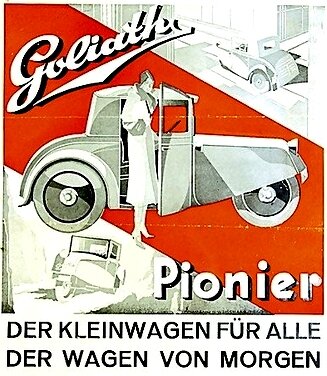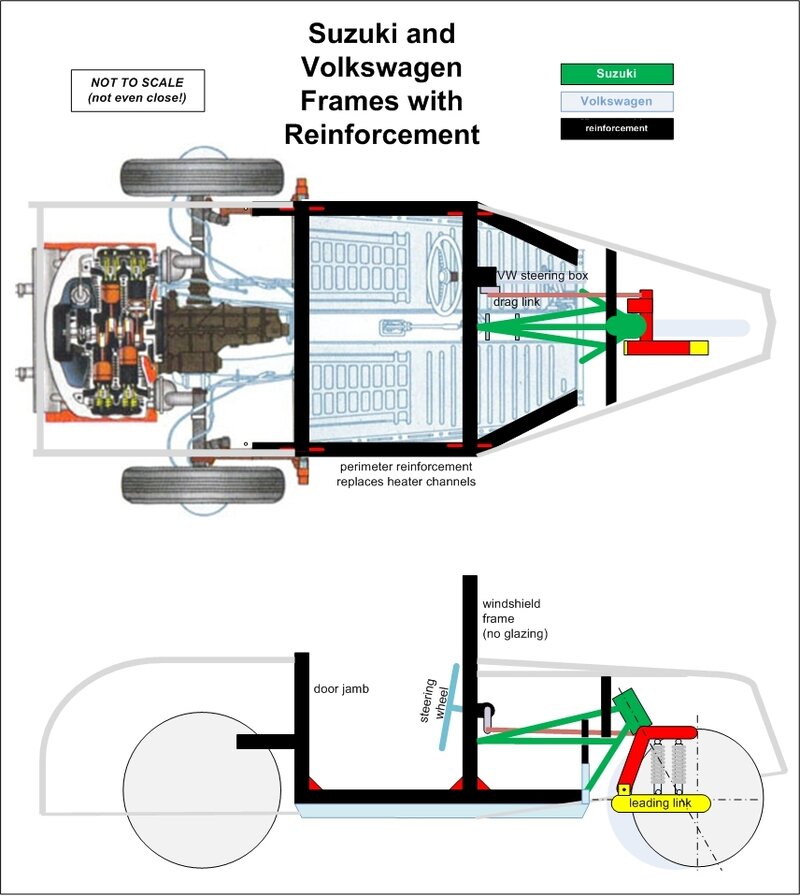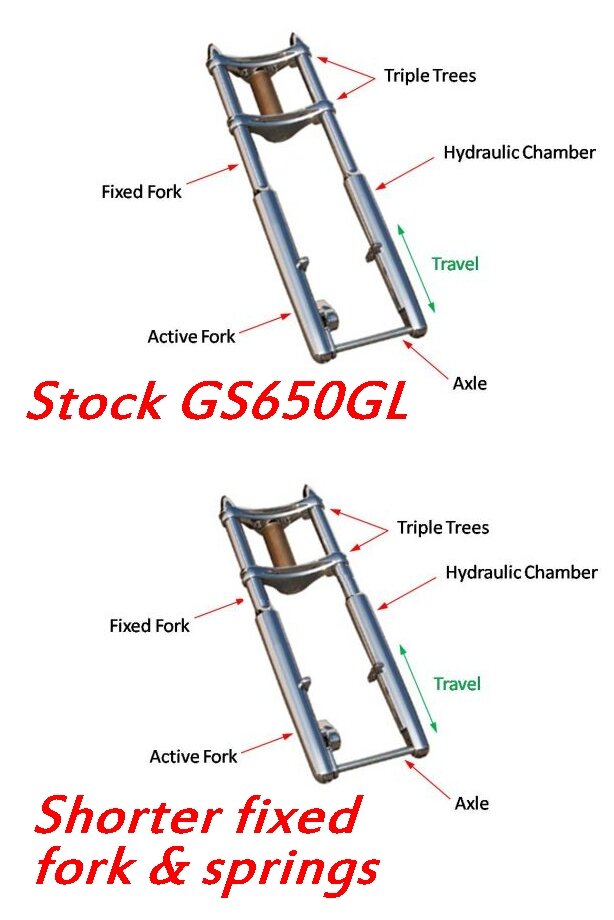Navigation
Install the app
How to install the app on iOS
Follow along with the video below to see how to install our site as a web app on your home screen.
Note: This feature may not be available in some browsers.
More options
You are using an out of date browser. It may not display this or other websites correctly.
You should upgrade or use an alternative browser.
You should upgrade or use an alternative browser.
Shortening forks on GS650
- Thread starter carcentric
- Start date
Making a low rider? My fear with this on a trike would be even more effort required to turn.
- Thread starter
- #3
Making a low rider? My fear with this on a trike would be even more effort required to turn.
This front end is for the trike shown in my avatar. Unless I add a lot of rake or shorten the forks, the "fairing" (hood) will need a large opening for the top of the forks to poke through (ugly solution).
It'll have a steering wheel and geared steering box, so effort's not a problem.
Pix and plans at:
http://carcentric.com/Les.htm
It'll have a steering wheel and geared steering box, so effort's not a problem.
In that case, I don't see an issue shortening them. Have you looked at a motorcycle salvage to see if you can find shorter forks already done? Might be cheaper and less headache.
- Thread starter
- #5
No luck there - they said they don't remember ever seeing any, either.
Still hoping for input on the OP: "What's involved in shortening the fixed (inner) fork tubes - and springs? . . ."
I presume there's more to it than disassemble, cut 3" off bottom of springs, cut 3" off bottom of tubes, and reassemble. For example, any machine shop work necessary?
Still hoping for input on the OP: "What's involved in shortening the fixed (inner) fork tubes - and springs? . . ."
I presume there's more to it than disassemble, cut 3" off bottom of springs, cut 3" off bottom of tubes, and reassemble. For example, any machine shop work necessary?
No luck there - they said they don't remember ever seeing any, either.
Still hoping for input on the OP: "What's involved in shortening the fixed (inner) fork tubes - and springs? . . ."
I presume there's more to it than disassemble, cut 3" off bottom of springs, cut 3" off bottom of tubes, and reassemble. For example, any machine shop work necessary?
I would be wary about 3" off the springs. I have lowered bikes using a Progressive Suspension lowering set of springs and t his lowers about one inch or 1 1/2 inches.... can't recall for sure. There is a piece of PVC pipe that comes with each spring that puts a bit of load on the shorter springs so they don't klunk going over railroad tracks.
This guy has been in the fork business forever and can likely be a better source of shorter fork tubes and has decent prices as I recall:
http://www.frankmain.qpg.com/
If I were doing this project I would seriously consider cutting the fork stem and re-welding it for MORE rake to have the steering sit lower and it will also have the benefit of handling better. Not sure how a steering wheel would work or why you would want one.
Be interested in hearing about this.
Last edited:
Loner
VW Tech Expert
Simplify your problem - pick up a used springer fork set. That way all geometries and functions are easy to interpret and modify as needed. That way all your concerns with proper operation of the finished product will be alleviated right up front (you mentioned that you are already concerned about keeping full stroke and ride comfort).
- Thread starter
- #8
. . . Not sure how a steering wheel would work or why you would want one. Be interested in hearing about this.
I'm working on visually replicating a 1932 Goliath Pionier and it has a steering wheel:

My frame combines a VW bug pan and the front half of the Suzuki frame. Lowering the Suzuki neck is so it won't stick out the top of the replica's hood. Since my OP in this thread, I've learned about the Trimuter front end and, since it usually uses a VW bug wheel/brake (and speedo drive), I'm planning to build one:

Looks like it will put the Suzuki frame's neck about as low as one could go.
I don't know if any of the angles/lengths of the Trimuter design are critical, though, and the Trimuter's designer won't sell just the front end plans, so I'm open to input on that and how to best join the Suzuki stem to the newly fabbed assembly.

More pix/text at http://www.carcentric.com/Les.htm
Not enough in the drawing above to give you any tips. How does the leading link arm keep from just colapsing? I assume the leading link moves up and down to provide some suspension? Does it have a spring? How is the steering mechanism connected to the neck? Seems to me you would have to have a supported steering stem so the neck could turn on bearings around the stem.
- Thread starter
- #10
wiredgeorge;325276" ; rel= said:.
. . How does the leading link arm keep from just colapsing? I assume the leading link moves up and down to provide some suspension? Does it have a spring? How is the steering mechanism connected to the neck? . . .
In the original Trimuter front end (the drawing you included in your post), there is a single VW coilover shock between points 1 and 2 (top of orange fork to front of yellow leading arm).
Making things more difficult in an effort to be different (and use parts I already have), my version uses two Suzuki rear coilovers set vertically.

Either way, yes, the leading arm is hinged for up-down movement and the fork is connected to the neck stem for rotation (steering) movement (the Suzuki forks, triple tree, handlebar, etc.
are not used). A steering drag link would be fabricated and joined to the fork via a Heim joint attached to the driver side fork leg .
As to the lengths/angles I'd like input on:
1. Is a 2" trail the goal with this sort of front end?
2. Is level/horizontal the best orientation for the leading arm/link?
3. Should the leading arm and fork be as short as possible while allowing at least 3/4" clearance between front end parts and tire?
4. What dimension tubing would be light weight yet safe? Would 1" square, .125" wall steel be strong enough?
If not, what do you recommend?
5. Any ideas on how to join the neck stem from the Suzuki to the cross piece of the orange fork?
Just weld 'er up or something more elaborate involving a paid-for machinist?
Loner
VW Tech Expert
Maybe I can help. Of the many trikes that I have built, one of them was a Trimuter. So i'll offer my recommendations to your plans and try to answer some of your specific questions.
What's involved in shortening the fixed (inner) fork tubes - and springs? How much can be removed before travel is compromised?
- Shorten hydraulic tubes at the top, not the bottom. Disassemble each fork tube, have a machinist cut the desired length off and rethread the inside of the tube for the cap threads. Then shorten the preload tube (like pvc pipe usually) an equal distance. You may need to trim a bit off the bottom of the spring(s) to get the desired overall shortened length. It appears that with your latest questions (below) you have now elected to fabricate a Trimuter style fork assembly, so I'll try to address those ideas.
As to the lengths/angles I'd like input on:
1. Is a 2" trail the goal with this sort of front end?
- 2" inches of trail will be great for whatever design you go with. For a vehicle like you are fabricating, I'd recommend a rake angle of 28 degrees from vertical. That would be achieved as you attach the salvaged neck to the new framework. That would make for some easy steering and stable driving characteristics.
2. Is level/horizontal the best orientation for the leading arm/link?
Level is good design but it needs to be a 'loaded' level. That can be adjusted as the shock mount points are determined. Shock(s) should be mounted at an angle similar to the neck rake, again that would be good angle measured under load.
3. Should the leading arm and fork be as short as possible while allowing at least 3/4" clearance between front end parts and tire?
- No reason for them to be as short as possible. See explanation below.
4. What dimension tubing would be light weight yet safe? Would 1" square, .125" wall steel be strong enough? If not, what do you recommend?
- 1" @ 1/8" won't be strong enough. I would go with at least 1.5" @ 3/16" to feel comfortable. I used 2" @ 1/4" but I was purposely building a heavy vehicle.
5. Any ideas on how to join the neck stem from the Suzuki to the cross piece of the orange fork? Just weld 'er up or something more elaborate involving a paid-for machinist?
- If you are going with the Trimuter design, then keep the triple trees with the bare fork tubes from your donor vehicle. With the tubes bolted solidly in the triple trees, cut the fork tubes below the lower tree to a length that will go all the way through the cross piece (orange). With the bottom of the triple tree setting flat on the cross piece, weld those tubes into mating holes drilled through the cross piece. That way, the triple trees can be disassembled if needed and will provide a strong assembly for the front end using the original Suzuki components.
Everything in this type design orients around the shock(s) specifications. Shock length, load rating, travel, etc. are all critical considerations to the fork design. And there are two approaches to incorporating those shock specs. You can design your chassis as you'd like it to be and let those design factors determine the shock specs that you need, or alternatively you can select the shock(s) that you want to use and alter the design of your chassis to accept the shock characteristics. You seem to be choosing the latter so you can use your Suzuki shocks. So to go forward get the specs on your shock, and that will determine whether you should use one or both shocks and how they should be oriented in your chassis.
I hope I didn't ramble too much, but I do try to go step by step in engineering advice, and to explain the whys and whatfors as we go.
And, as always, my advice is guaranteed or your money back!
What's involved in shortening the fixed (inner) fork tubes - and springs? How much can be removed before travel is compromised?
- Shorten hydraulic tubes at the top, not the bottom. Disassemble each fork tube, have a machinist cut the desired length off and rethread the inside of the tube for the cap threads. Then shorten the preload tube (like pvc pipe usually) an equal distance. You may need to trim a bit off the bottom of the spring(s) to get the desired overall shortened length. It appears that with your latest questions (below) you have now elected to fabricate a Trimuter style fork assembly, so I'll try to address those ideas.
As to the lengths/angles I'd like input on:
1. Is a 2" trail the goal with this sort of front end?
- 2" inches of trail will be great for whatever design you go with. For a vehicle like you are fabricating, I'd recommend a rake angle of 28 degrees from vertical. That would be achieved as you attach the salvaged neck to the new framework. That would make for some easy steering and stable driving characteristics.
2. Is level/horizontal the best orientation for the leading arm/link?
Level is good design but it needs to be a 'loaded' level. That can be adjusted as the shock mount points are determined. Shock(s) should be mounted at an angle similar to the neck rake, again that would be good angle measured under load.
3. Should the leading arm and fork be as short as possible while allowing at least 3/4" clearance between front end parts and tire?
- No reason for them to be as short as possible. See explanation below.
4. What dimension tubing would be light weight yet safe? Would 1" square, .125" wall steel be strong enough? If not, what do you recommend?
- 1" @ 1/8" won't be strong enough. I would go with at least 1.5" @ 3/16" to feel comfortable. I used 2" @ 1/4" but I was purposely building a heavy vehicle.
5. Any ideas on how to join the neck stem from the Suzuki to the cross piece of the orange fork? Just weld 'er up or something more elaborate involving a paid-for machinist?
- If you are going with the Trimuter design, then keep the triple trees with the bare fork tubes from your donor vehicle. With the tubes bolted solidly in the triple trees, cut the fork tubes below the lower tree to a length that will go all the way through the cross piece (orange). With the bottom of the triple tree setting flat on the cross piece, weld those tubes into mating holes drilled through the cross piece. That way, the triple trees can be disassembled if needed and will provide a strong assembly for the front end using the original Suzuki components.
Everything in this type design orients around the shock(s) specifications. Shock length, load rating, travel, etc. are all critical considerations to the fork design. And there are two approaches to incorporating those shock specs. You can design your chassis as you'd like it to be and let those design factors determine the shock specs that you need, or alternatively you can select the shock(s) that you want to use and alter the design of your chassis to accept the shock characteristics. You seem to be choosing the latter so you can use your Suzuki shocks. So to go forward get the specs on your shock, and that will determine whether you should use one or both shocks and how they should be oriented in your chassis.
I hope I didn't ramble too much, but I do try to go step by step in engineering advice, and to explain the whys and whatfors as we go.
And, as always, my advice is guaranteed or your money back!
- Thread starter
- #12
EXCELLENT! Much appreciated detail. I'll get back to you after I've digested as much as I can.Maybe I can help. Of the many trikes that I have built, one of them was a Trimuter. So i'll offer my recommendations to your plans and try to answer some of your specific questions. . . . I hope I didn't ramble too much, but I do try to go step by step in engineering advice, and to explain the whys and whatfors as we go. . . .
Welcome to the Trike Talk Community
Join our vibrant online community dedicated to all things Trikes! Whether you're a seasoned rider or just starting out, this is the place to share experiences, tips, and stories about your three-wheeled adventures. Explore modifications, maintenance advice, and rides, all while connecting with fellow trike enthusiasts from around the globe
Forum statistics
Trike Talk Community
Welcome to a community dedicated to the most diverse and fastest growing powersports segment, Motorcycle Trikes. Come join the discussion about the best makes and models, popular modifications and proven performance hacks, trike touring and travel, maintenance, meetups and more!
Register Already a member? LoginForum statistics







